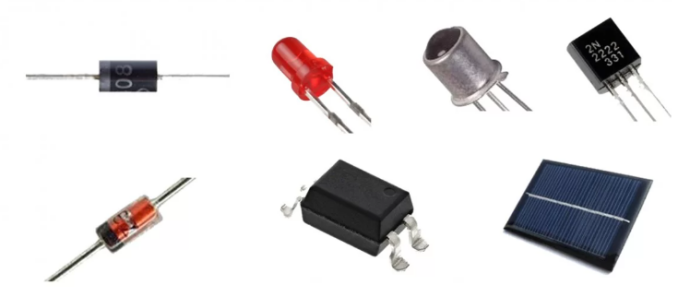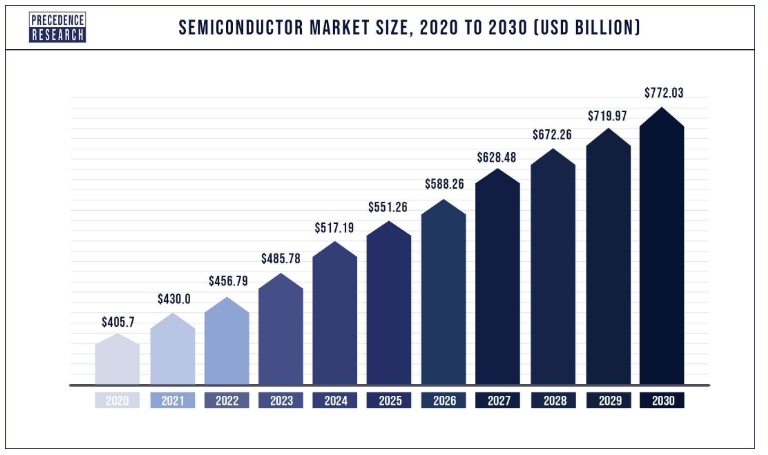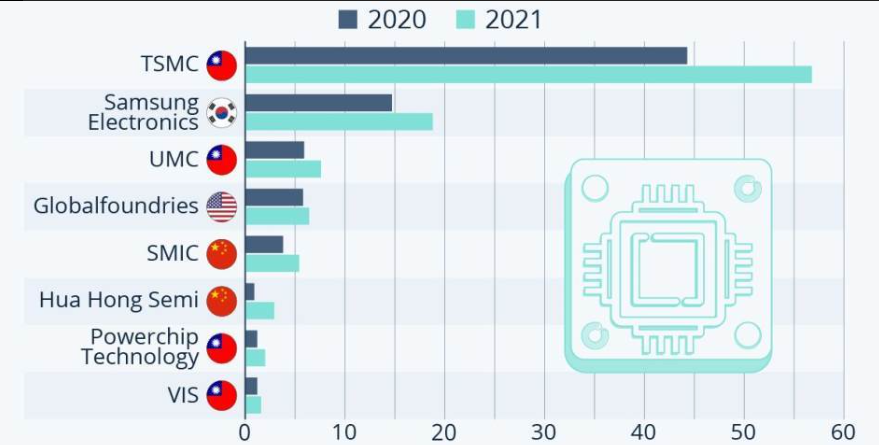Semiconductors are in everything from your cell phone to rockets. In this article, we will try to understand what makes them so special and why they are so important in our lives.
What are Semiconductors?
A semiconductor is the element whose conductivity changes based on environment. This special ability makes semiconductors the perfect brains for electronic devices. Circuits of small semiconductor switches, called transistors, are the heart of computer chips, and enable them to do math and run programs. Semiconductors have enabled electronics to become smaller, faster and more reliable. Computers are made up of semiconductors, which are called transistors. Computers use electric fields because heat is slow and would burn too much energy. We can turn wafer into a computer chip by printing a circuit of transistors on it, using a process called photolithography.
To make this process done, we should cover the wafer with a light sensitive material and expose it to light that we shine through a patterned mask, and then we develop the wafer, like film in photography, which leaves behind a pattern that becomes the circuit. Printing the transistors at once lets you make circuits that are smaller and cheaper if they are built from individual parts. Transistors make up the logic elements, the memory components, and the communication modules that let computers talk to each other. Because of semiconductors, transistors are added to almost any device we can think of, from house appliances such as toaster to rockets and spaceships. Semiconductors are the essentials of the technological revolution, as well as the essentials of tech innovations such as the internet, the computer, and the cellphone. No semiconductors - no information age.
What’s Applications of Semiconductor Devices?
Semiconductors are used in electronic applications, especially for the production of components such as transistors, diodes and integrated circuits. They are also used as accessories or add-ons for optical sensors, such as solid state lasers and some drive devices for power transmission systems.
Diodes are fundamental devices in semiconductor technology. Their special structure, which juxtaposes differently charged semiconductor materials so that they are in contact with each other, allows current to move freely in only one direction. Semiconductors are widely used as raw materials in the assembly of electronic elements that are part of our daily lives, such as integrated circuits. One of the main elements of an integrated circuit are transistors. Transistors are essentially dual diodes used to control electrical voltage and current, mostly at low values. A thyristor is an electronic component where current is blocked in both directions by default. The thyristor becomes conductive only when an electrical impulse is initiated by the control electrode.
They are used for controlling electric motors in e.g. vacuum cleaners, mixers or electric drills. When it comes to household and electrical appliances,dimmers and in various other situations, thyristors and triacs are needed. Triacs can be thought of as dual thyristors, but unlike thyristors, they are suitable for operation in AC circuits. Optoelectronics and displays are also some of the semiconductor products that enable the conversion of electronically generated data and energy into light emissions, and vice versa. They also include devices that interconnect optical and electrical components. In doing so, they act as transmitters or receivers. While LEDs generate light from electricity, they act as transmitters, photodiodes work as receivers, more precisely they convert light into electricity. Optoelectronic devices are built into many devices that we use every day such as LED displays and TFT displays.

Semiconductors are also the primary material of diodes used in electronic circuits to allow electrical current to flow in only one direction. Semiconductors are present in electronic devices that we use in our daily life, such as televisions, video devices, sound equipment, computers and mobile phones. Microprocessors or microchips are an integral part of computers, washing machines, smartphones and, eventually, cars. In four-wheelers, they are responsible for the proper functioning of air conditioners, airbags, electronic driver assistance systems, as well as window winders.
What Industries are Highly Dependable on Semiconductors?
Although semiconductors are used in a variety of fields, 4 industries are particularly dependent on and affected by their shortages. To make it clearer how significant they are and what the impact is in the case of production shortages, it should be said that chips are a vital part of many devices that we use in everyday life: from toasters to smartphones. A single Taiwanese company controls more than half of the global chip market share. That fact, along with the fact that making chips is an incredibly long, complex and expensive process, speaks volumes for why there aren't enough of them. No other single component is more "responsible" for significant challenges in global supply chains, as well as for the so-called bottlenecks that continue to define the economy in the ending Covid era.
● Car Industry
Even the most basic new cars rely on specialized microchips to function. Every car today uses semiconductors, and has been for some time. In fact, even key fobs can't work without chips. These chips, which represent a key technology in today's modern world, are the basic components of electrical systems – including those in vehicles. Of the total global production of semiconductors, between 8 and 12 percent ends up in the automotive industry. Some of the biggest names in the industry include Tesla, BMW, General Motors and Ford. The essence of semiconductors was shown on global market by the end of July 2021, when at least 17 factories in Europe and North America have either stopped or slowed production, due to a shortage of computer chips.
● Consumer Electronics
The consumer electronics industry snapped up many of the chips, which were later used to make cars, but even so - makers of equipment ranging from laptops and televisions to video game consoles and smartphones - are raising prices because of tight supplies. While brands love to brag about their latest high-end chips, consumer electronics still can't function without simple semiconductors. One of the examples is HP, which raised the price of printers by an average of 20% in one year, according to the WSJ. Bloomberg reported this summer that Sony does not plan to produce an adequate supply of the PlayStation 5 console until at least this year.
● Home Appliances
It's not just cars and phones that can't work without chips, but also your dishwasher, fridge, freezer and microwave - they cannot process without semiconductors.
● LED Lights
At the start of 2021, "LED Inside" reported that companies like Apple and Samsung are preparing to debut their latest laptops, tablets and TVs. They all had one thing in common - they were equipped with mini LED backlights, powered by chips that were increasingly difficult to find.
With manufacturers scrambling to "pick up" what's left of the chips that enable LED lighting, prices have naturally risen and contributed to inflation. By mid-summer last year, Taiwan's top three LED chip makers predicted that demand would continue to outstrip supply over the next few years.
Semiconductors - The Oil of Our Generation
The global semiconductor market was valued at USD 456.79 billion in 2022 and expected to reach USD 772.03 billion by. The global Semiconductor market was valued at USD 456.79 billion in 2022 and expected to reach USD 772.03 billion by In 2030, poised to grow at a compound annual growth rate (CAGR) of 6.6% during the forecast period 2022 to 2030. The Asia Pacific. Poised to grow at a compound annual growth rate (CAGR) of 6.6% during the forecast period 2022 to 2030 semiconductor market size was valued at USD 241.67 billion in 2021.

Companies such as TSMC, Samsung Electronics or UMC benefited from the increased demand and the simultaneous lack of supply in the two years of the pandemic, which is why, according to Statista, among other factors, they were able to increase sales due to the favorable development of prices for them and the high employment of production capacities. According to TrendForce analysts, Taiwanese manufacturer TSMC, known for producing chips for the iPhone and semiconductors for Intel, remained the market leader. Apple was responsible for about 25 percent of TSMC's total revenue of about $57 billion in 2021. Overall, the five top-selling manufacturers have a market share of around 90 percent. US-based Globalfoundries is the only chipmaker not based in the East Asia region among the top eight on the list and is currently ranked 4th in terms of revenue in 2020 and 2021.
In the first quarter of 2022, the market share of this company was around six percent. In order to expand the market position of American chip manufacturers, Congress passed the CHIPS Act for the USA during the year, which is intended for the industry with additional financial and all other incentives for production and research. The Chinese SMIC, which recently manages to produce more modern chips independently technology, without US patents and any other rights is currently in the fifth position and takes the fifth place in terms of income on this list. The main fear is that semiconductor companies are on the verge of repeating the scenario of 2018, when stocks hit record highs and rising chip prices led to record sales. This led to double and triple buying of the chips, before prices went even higher. These market trends are showing the inevitable need of following and understanding the importance of semiconductors in our daily life. They might not be known to us, but their price is directly shaping prices of all electric devices which we use today.
So, what we can expect is more of big geopolitical focus over these little particles. Along with it, like in previous decades we can expect more innovations of semiconductor nanomaterials development. By some indicators the global semiconductor industry is anticipated to grow to US$1 trillion in revenues by 2030. What we can expect is further growth in investment, especially in advanced wafer manufacturing materials, equipment, and services. Besides that, the accelerated industrial adoption of new technologies in artificial intelligence (AI) and the Internet of Things (IoT) is already shown as a necessity in coming years.

About the Author
This article was written by Heisener, an industry-leading electronic components supplier in semiconductor industry. They commit to delivering most-needed, obsolete, franchised, and hard-to-find parts to clients worldwide.
Media Contact
Name: Elsie Deng
Email: sns@heisener.com